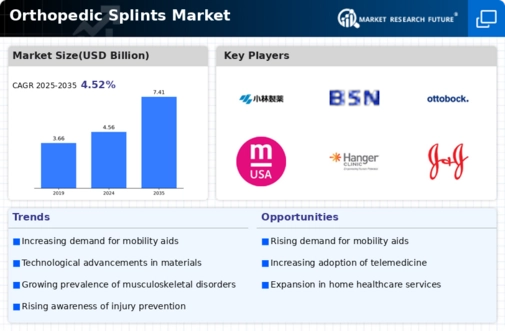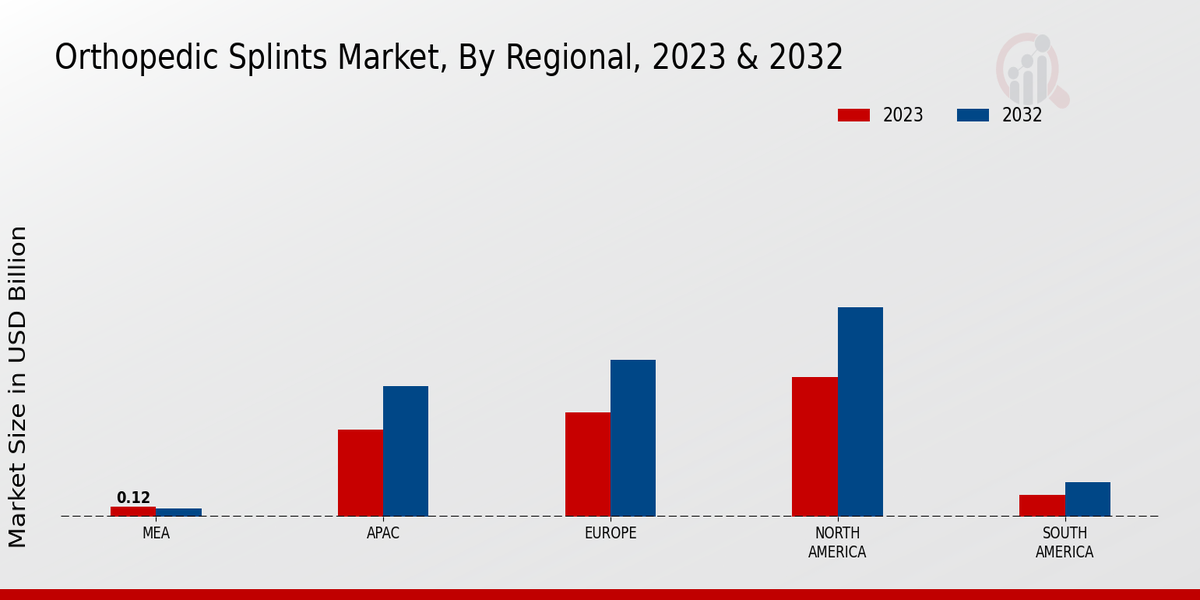Market Growth Charts
Increasing Geriatric Population
The aging population globally contributes to the expansion of the Global Orthopedic Splints Market Industry. Older adults are more susceptible to fractures and other orthopedic conditions, necessitating the use of splints for treatment and recovery. According to demographic studies, the proportion of individuals aged 65 and older is projected to rise significantly in the coming years. This demographic shift is likely to increase the demand for orthopedic splints, as they are essential for managing age-related musculoskeletal issues. Consequently, the market is anticipated to reach 7.41 USD Billion by 2035, driven by the growing need for orthopedic care among the elderly.
Rising Awareness of Orthopedic Care
There is a notable increase in awareness regarding orthopedic care and injury prevention, which positively impacts the Global Orthopedic Splints Market Industry. Educational initiatives and campaigns by healthcare organizations emphasize the importance of early intervention and proper management of orthopedic injuries. This heightened awareness encourages individuals to seek medical attention sooner, leading to increased prescriptions for orthopedic splints. As healthcare providers adopt more proactive approaches to treatment, the demand for splints is likely to rise, further contributing to the market's growth. This trend aligns with the overall expansion of the healthcare sector, which is increasingly focused on patient-centered care.
Expansion of Healthcare Infrastructure
The Global Orthopedic Splints Market Industry benefits from the ongoing expansion of healthcare infrastructure, particularly in developing regions. Improved access to healthcare facilities and services enhances the availability of orthopedic care, including the provision of splints. Governments and private sectors are investing in healthcare infrastructure to meet the rising demand for medical services. This expansion is likely to facilitate better diagnosis and treatment options for orthopedic injuries, thereby increasing the utilization of splints. As healthcare systems evolve, the market is poised for growth, reflecting the broader trends in global health and wellness.
Rising Incidence of Orthopedic Injuries
The Global Orthopedic Splints Market Industry experiences growth due to the increasing prevalence of orthopedic injuries, which are often associated with sports, accidents, and aging populations. For instance, the World Health Organization indicates that musculoskeletal disorders are among the leading causes of disability worldwide. This trend is likely to drive demand for orthopedic splints, as they play a crucial role in the management and rehabilitation of such injuries. As the market is projected to reach 4.56 USD Billion in 2024, the need for effective treatment solutions becomes more pronounced, thereby enhancing the market's growth trajectory.
Technological Advancements in Splint Design
Innovations in the design and materials used in orthopedic splints significantly influence the Global Orthopedic Splints Market Industry. The introduction of lightweight, breathable, and adjustable splints enhances patient comfort and compliance. For example, the use of thermoplastic materials allows for custom molding, which can improve the fit and effectiveness of the splint. These advancements not only cater to the needs of healthcare providers but also align with patient preferences for more comfortable and effective treatment options. As a result, the market is expected to grow at a CAGR of 4.51% from 2025 to 2035, reflecting the impact of these technological improvements.













